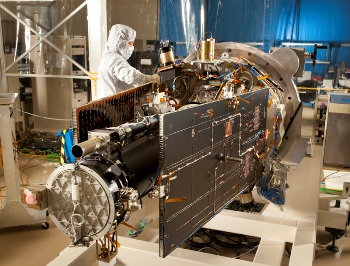Apr 18 2013
Scientists will soon gain a better view into energy and plasma movement near the surface of the sun, thanks to delivery of the Interface Region Imaging Spectrograph (IRIS) spacecraft to Vandenberg Air Force Base, Calif. in preparation for launch.
 Interface Region Imaging Spectograph (IRIS) satellite in Lockheed Martin Space Systems Company in Sunnyvale, Calif., with the solar telescope and bus structure fully integrated.
Interface Region Imaging Spectograph (IRIS) satellite in Lockheed Martin Space Systems Company in Sunnyvale, Calif., with the solar telescope and bus structure fully integrated.
Part of NASA’s Small Explorer (SMEX) Mission, which delivers space exploration missions costing less than $120 million, IRIS was designed and built at Lockheed Martin’s [NYSE: LMT] Space Systems Company Advanced Technology Center (ATC) in Palo Alto, Calif. The program was developed with support from Lockheed Martin’s Civil Space line of business as well as partners Smithsonian Astrophysical Observatory, Montana State University, Stanford University and the University of Oslo. The launch of IRIS will not take place before May 28.
“The entire IRIS team is enormously pleased that we’ve reached this crucial milestone,” said Gary Kushner, Lockheed Martin IRIS program manager. “After many months of hard work by the Lockheed Martin team and all of our collaborators and subcontractors in designing, engineering, building and testing the instrument and integrated spacecraft, our goal of putting it into orbit is in sight and we look forward to producing great science at a low cost.”
“The IRIS spacecraft and instrument are emblematic of the wide range of capabilities that Lockheed Martin brings to the exploration and utilization of space,” said Dr. Kenneth Washington, vice president of the ATC. “The IRIS solar telescope is the latest in a five decade heritage of sensing payloads which, cumulatively, have operated for over 800 years in space. Moreover, our small satellite capabilities have supported multiple successful missions including IKONOS, Lunar Prospector, IMAGE, and now IRIS.”
NASA’s Ames Research Center, Moffett Field, Calif., is responsible for mission operations and the ground data system. The Norwegian Space Centre will capture the IRIS data with their antennas in Svalbard, inside the Arctic Circle in northern Norway. The science data will be managed by the Joint Science Operations Center of the Solar Dynamics Observatory, run by Stanford and Lockheed Martin. NASA’s Goddard Space Flight Center in Greenbelt, Md., oversees the SMEX project.
The goal of the IRIS program is to better understand how energy and plasma move from a lower layer of the sun’s surface called the photosphere, through the chromosphere layer and to the outer corona layer. Observation into this movement has been a fundamental challenge in solar and heliospheric science, and the IRIS mission will open a window of discovery into this crucial region by providing observations necessary to pinpoint physical forces at work in this little understood piece of real estate near the surface of the Sun.
“The interpretation of the IRIS spectra is a major effort coordinated by the IRIS Science Team that will utilize the full extent of the power of the most advanced computational resources in the world. It is this new capability, along with development of state of the art codes and numerical models by the University of Oslo that capture the complexities of this region, which make the IRIS mission possible. Without these important elements we would be unable to fully interpret the IRIS spectra,” said Dr. Alan Title, IRIS principal investigator and physicist at the ATC Solar and Astrophysics Laboratory in Palo Alto. “With IRIS, we have a unique opportunity to provide significant missing pieces in our understanding of energy transport on the Sun. The complex processes and enormous contrasts of density, temperature and magnetic field within this interface region require instrument and modeling capabilities that are now finally within our reach.”
The IRIS observatory will fly in a Sun-synchronous polar orbit for continuous solar observations on a two-year mission. It will obtain ultraviolet spectra and high resolution images focused on the chromosphere and the transition region to the outer corona. Spectra will cover temperatures from 4,500 K to 107 K, with images covering temperatures from 4,500 to 65,000 K.
The NASA SMEX Program is designed to provide frequent, low-cost access to space for heliophysics and astrophysics missions using small to mid-sized spacecraft. The program also seeks to raise public awareness of NASA's space science missions through educational and public outreach activities.
The ATC is the research and development organization of Lockheed Martin Space Systems Company (LMSSC) and creates the technology foundation for the company’s business. In addition, the ATC conducts research into understanding and predicting space weather and the behavior of our Sun, including its impacts on Earth and climate. It has a five-decade-long heritage of spaceborne instruments.
LMSSC, a major operating unit of Lockheed Martin Corporation, designs and develops, tests, manufactures and operates a full spectrum of advanced-technology systems for national security and military, civil government and commercial customers. Chief products include human space flight systems; a full range of remote sensing, navigation, meteorological and communications satellites and instruments; space observatories and interplanetary spacecraft; laser radar; ballistic missiles; missile defense systems; and nanotechnology research and development.